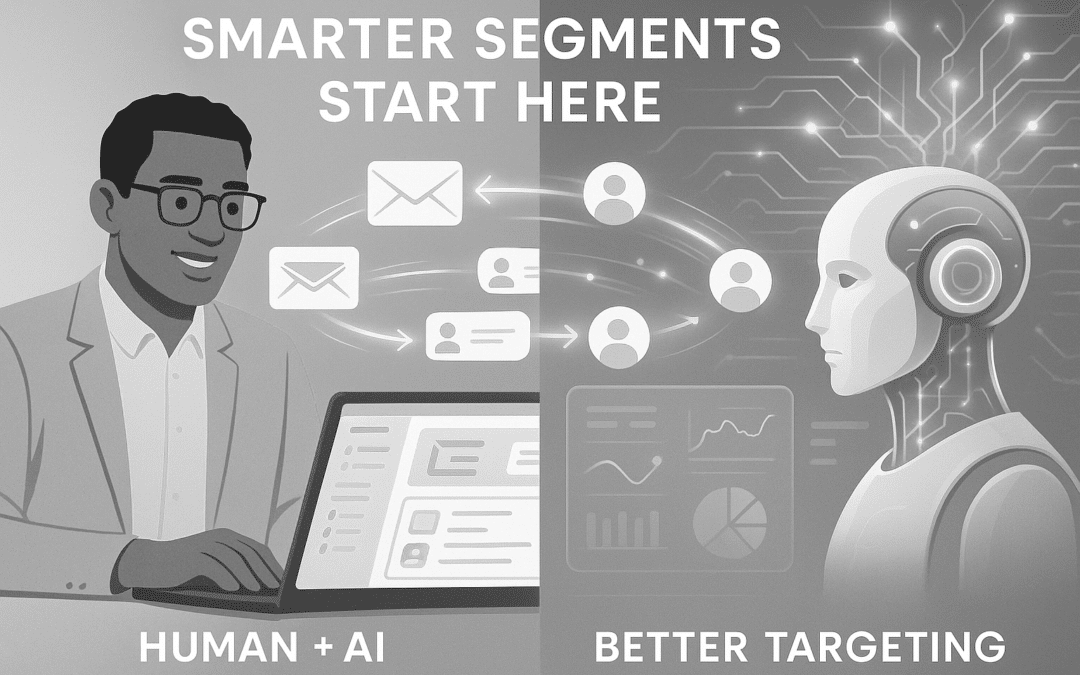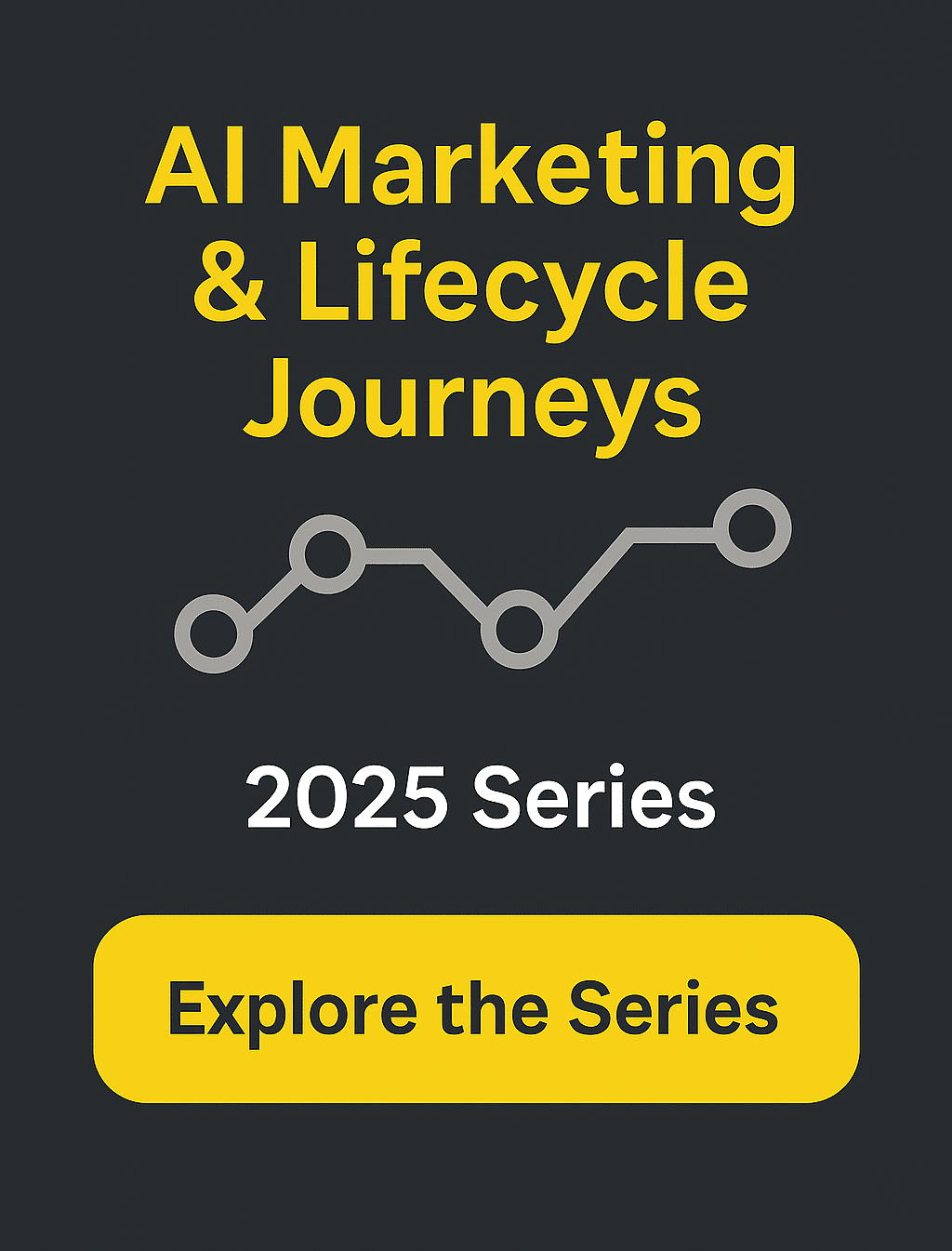⚠️ Work in Progress
These posts are part of an evolving series on AI and lifecycle marketing. I’m in the process of restructuring and expanding them into more digestible segments. If you’re here early, thank you. You’re catching the thinking in motion.
This blog post is part of the AI Marketing & Lifecycle Journeys: 2025 Series. If you’re new here, I recommend starting with my foundational article: AI-Driven Lifecycle Marketing.
Did you know that companies using AI-powered segmentation see up to 41% more revenue per email? The days of basic demographic targeting are behind us. Today’s consumers expect personalization that evolves with their behavior. AI is making it possible.
Segmentation Is Evolving Fast
Email marketing segmentation has always helped marketers target the right audience with the right message. But the game is changing dramatically. Consumer behavior has become more dynamic and data-rich. The result is that static segments based on basic rules (like age or location) increasingly ineffective. The real shift? AI-driven segmentation. Dynamic, behavior-aware, and predictive segmentation is pushing email strategy into entirely new territory.
“The true power of AI in retail marketing lies not in automation, but in the intelligent orchestration of customer experiences across time and channels.” ~ Bommisetti & Chowdhury (2024)
This article explores how AI is changing segmentation. We’ll cover clustering algorithms and real-time behavior tracking. We’ll also discuss what this means for creating smarter campaigns both now and in the future.
Segmentation Then vs. Now: The Shift to Intelligence
Traditional Approach: Static Rules
Traditional segmentation used rules to group people by gender, ZIP code, and how often they shopped. It worked… until it didn’t. Today’s consumers see static segments and stale messages as less relevant. They want more personalization as their behaviors change quickly.
The AI Difference: Dynamic Learning
AI segmentation changes the game by leveraging three key components:
- Data patterns: Uncovering hidden trends
- Identifies correlations within customer actions.
- Analyzes repeat purchases, browsing patterns, and email engagement.
- Reveals behavior evolution over time.
- Machine learning: Making adaptive predictions
- Uses algorithms to identify patterns autonomously.
- Learns continuously from both historical and real-time data.
- Makes predictions without manual programming intervention.
- Behavioral insights: Actionable intelligence
- Identifies users likely to churn before they leave.
- Predicts content types that will drive engagement.
- Determines optimal timing for email delivery.
These elements create a flexible segmentation system. It adapts to your audience, so it doesn’t force them into fixed categories.
“Predictive segmentation is not just a tool — it’s a shift in mindset, where marketers become data interpreters rather than list builders.” ~ Akter & Islam (2024)
Inside AI-Driven Segmentation: The New Toolbox
AI segmentation doesn’t just automate what marketers used to do manually. It introduces entirely new ways to understand and reach audiences:
Clustering Algorithms: Finding Natural Audience Groups
These powerful tools group users by their shared behaviors or preferences. They do this without using predefined labels. By analyzing the metrics below, they find hidden audience segments that demographic data might miss.
- Purchase frequency patterns
- Content consumption habits
- Engagement timing preferences
Predictive Models: Anticipating Needs Before They Arise
By analyzing past behavior, these models:
- Flag potential churners before they disengage.
- Identify next-best content recommendations.
- Determine purchase readiness signals.
- Enable proactive rather than reactive campaign strategies.
Sentiment Analysis: Aligning with Emotional States
AI can now detect emotional tone in:
- Email responses
- Survey feedback
- Support interactions
- Social mentions
Emotional intelligence helps marketers tweak the tone, timing, and content of messages. This way, they can better connect with subscribers’ current feelings.
Real-time Decision Engines: Dynamic Segmentation on the Fly
These systems process behavioral signals instantaneously:
- Click patterns
- Scroll depth
- Abandoned carts
- Page viewing duration
They quickly recategorize users into the best segment. This helps create highly relevant messages, even when behaviors change from moment to moment.
“AI doesn’t just help you find your customers — it helps you understand when and why they’re ready to act.” ~ Bulut & Taşkın (2024)
Industry Impact: AI Segmentation in Action
AI segmentation is not just a future promise. It is already changing how companies connect with their audiences in various sectors. Here’s what it looks like in practice:
Retail
A beauty brand uses AI to segment based on real-time browsing behavior. Shoppers who spend time on product pages but don’t buy are placed in a “high interest, no purchase” group. These users get personalized emails with reviews and special discounts. This helps reduce cart abandonment and boosts their confidence to buy.
Education (EdTech)
A professional development platform segments learners by lifecycle stage and engagement patterns:
- New users receive orientation content.
- Inactive users (10+ days without login) are flagged by AI churn prediction.
- Re-engagement campaigns feature personalized course recommendations based on initial interests.
This approach has significantly improved course completion rates and overall platform retention.
Healthcare
A wellness app uses sentiment analysis on email replies and in-app feedback. This helps move users into different motivation-based groups.
- “Goal-oriented” users receive data-driven insights.
- “Support-seeking” users get community success stories.
- “Frustrated” users receive calming check-ins and simplified action plans.
This emotionally intelligent approach builds trust while respecting each user’s unique journey.
Nonprofits
A wildlife conservation group uses AI to spot donor habits related to campaigns or events. Donors are dynamically segmented into:
- “Urgent-action givers” (respond to time-sensitive appeals).
- “Monthly sustainers” (prefer recurring support options).
- “First-timers” (need additional engagement touchpoints).
Each segment receives customized impact updates and calls-to-action reflecting their giving style. This deepens donor engagement and increasing retention.
AI segmentation goes beyond simply splitting lists. It involves creating smart customer journeys. These journeys react to behavior, intent, and emotions as they happen.
Marketing AI Institute (2023) reports that brands using these strategies have boosted revenue per email by up to 41%. They achieved this by syncing AI recommendations with real-time user data. This shows that these results are real and happening now.
Navigating the Challenges: What to Watch Out For
While AI segmentation offers tremendous potential, implementation comes with significant challenges. Here’s what marketers need to prepare for:
Data Quality Issues
The challenge: Even cutting-edge AI tools are only as effective as the data they analyze. Incomplete, outdated, or poorly structured information leads to flawed segments and irrelevant messaging.
Strategic response: Invest in robust data hygiene practices before launching AI initiatives. Regular data audits and cleansing processes are essential foundations for success.
Bias in Training Data
The challenge: AI models trained on biased or unrepresentative data can reinforce stereotypes. They may also leave out certain audience groups. This can cause ethical targeting problems and harm reputations.
Focus on diversity in your datasets. Also, set up regular bias audits. This will help create fair segmentation models.
⚠️ Important: A model trained on biased data will mirror that bias in your segments. Regular audits are your best defense.
Legal Compliance and Privacy Concerns
The challenge: Rapidly changing regulations like GDPR, CCPA, and other global data privacy laws make AI-powered segmentation tricky. It needs careful attention to consent and transparency rules.
Strategic response:
- Use strong consent management.
- Anonymize data when needed.
- Ensure clear privacy communication.
This is especially important for AI decisions.
The “Creep Factor” Risk
The challenge: Hyper-specific messaging based on inferred or sensitive data can feel invasive. Creepy messaging will erode customer trust.
Strategic response: Set clear internal rules for personalization limits. Also, regularly check how comfortable the audience feels with different methods.
Technical Integration Hurdles
The challenge: Many organizations find it hard to connect AI systems with their martech stacks. This limits data flow between CRM, ESP, and analytics platforms.
Focus on solutions with strong APIs and ready-made integrations for your main marketing platforms.
Team Skill Gaps
The challenge: Effective AI segmentation needs both marketing intuition and data skills. Many teams don’t have these abilities in-house.
Strategic response: Invest in upskilling programs. Also, create cross-functional teams that combine marketing skills and data science.
Bommisetti et al. (2024) stress that ethical data use must keep pace with technology. Marketers should take the lead in setting responsible standards for AI-customer interactions.
The Future of Segmentation: Human + AI Partnership
Looking ahead, segmentation is evolving from reactive grouping to proactive orchestration. Tomorrow’s campaigns won’t just focus on “who” someone is, but also “when,” “why,” and “how” they engage.
Hyper-segmentation Powered by Real-time Signals
Rather than broad audience categories, marketers will work with fluid micro-segments. These micro-segments, be shaped by continuous data streams, will evolve in real time. This new focus will allow marketers to maintain perfect alignment with the swift changes in user needs and intentions.
AI-generated Content Matched to Segment Psychology
Natural Language Generation tools are already writing high-performing email copy. The next evolution will customize voice, tone, and calls-to-action based on the inferred emotional state of each segment:
- Reassuring anxious users with confidence-building language.
- Energizing motivated segments with dynamic, action-oriented copy.
- Engaging disinterested audiences with humor or intriguing questions.
Omnichannel Orchestration
AI will sync messages across all touchpoints. This means emails will match in-app experiences, website actions, and SMS or push notifications. This orchestration will create smooth, personalized customer journeys. And, better still, they will feel consistent across all channels.
Hicham et al. (2024) describe this future state perfectly: “AI segmentation thrives when global intelligence meets local insight.” The marketer’s role won’t disappear, it will transform. Instead of list builders, we’ll become behavior interpreters, strategy architects, and experience curators.
Final Thoughts: The Human Element Remains Essential
The future of email segmentation goes beyond better targeting. It focuses on gaining a deeper understanding. With AI, marketers are not just segmenting audiences. They are creating responsive experiences that adjust to behavior signals in real time.
“Segmentation is no longer static. It’s a dynamic process, increasingly shaped by real-time behavioral data and machine learning—but rooted in timeless marketing principles.” ~ Chaffey (2022)
The leaders in this next era won’t be those who blindly chase every new tool. They will be those who thoughtfully blend human empathy with machine intelligence to create marketing that genuinely resonates. The question isn’t whether marketers will adopt AI for segmentation. It’s how wisely and responsibly they’ll implement it.
This blog post is part of the AI Marketing & Lifecycle Journeys: 2025 Series. Read the next post in the series: AI-Powered Email Personalization. Learn how to scale 1:1 experiences across your email campaigns using AI, without drowning in manual setup or versioning headaches.
Works Cited
- Akter & Islam, 2024. Predictive Segmentation in CRM Read on ResearchGate
- Bommisetti & Chowdhury, 2024. AI in Retail Orchestration Read on ResearchGate
- Bulut & Taşkın, 2024. AI in CRM and E-commerce Conference Paper — AISel
- Chaffey, 2022. Digital Marketing: Strategy, Implementation and Practice View on Pearson
- Hicham et al., 2024. Big Data & AI in E-commerce Marketing Springer Chapter
- Jayakumar & Kumar, 2024. AI for Personalized Recommendations (IEEE) View Abstract
- Marketing AI Institute, 2023. AI and Email Personalization Insights Read Article




